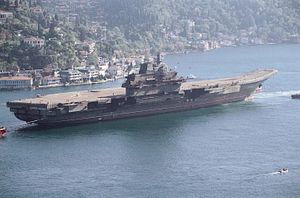The Chinese People’s Liberation Army Navy’s (PLAN’s) first indigenously designed and developed aircraft carrier Shandong is expected to be launched in the coming weeks, China’s Ministry of Defense announced on February 21.
The aircraft carrier’s “scaffold has been removed and red undercoat has been painted below the ship’s waterline in Dalian, northeastern Liaoning Province, and that a launching ceremony will soon be held,” according to China Military Online. Once launched, the ship is expected to be commissioned into service with the PLAN’s North Sea Fleet or East Sea Fleet within the next two years.
The new Type 001A aircraft carrier is an improved variant of the PLAN’s only operational aircraft carrier, the 60,000-ton Type 001 Liaoning — a retrofitted Soviet-era Admiral Kuznetsov-class multirole aircraft carrier. With a displacement of around 65,000 tons, the Shandong will only be slightly larger than the Type 001 ship.
Powered by oil-fired boilers and steam turbines, the ship will have an estimated operational range of 3,850 nautical miles (7,130 kilometers) at about 32 knots.
Like the Liaoning, China’s second carrier will be able to accommodate up to 24 Shenyang J-15 multirole fighter jets, a variant of the fourth-generation Sukhoi Su-33 twin-engines air superiority fighter, as well as up to ten rotary wing aircraft such as Changshe Z-18, Ka-31, or Harbin Z-9 helicopters.
The new carrier will feature a so-called ski-jump assisted Short Take-Off But Arrested Recovery (STOBAR) launch system. “Based on information released by the Chinese defense ministry, 001A’s aircraft will still use the ski-jump method of taking off from a ski ramp on the front of the carrier just like its ‘sister,’ the Liaoning, rather than more advanced catapult technology used by U.S. aircraft carriers,” China Military Online reports.
This brings a number of disadvantages as I noted elsewhere:
Given the STOBAR system, aircraft launched from the carrier will also have a more limited operational range due to the fact that they need to expend a considerable amount of fuel during take-off in comparison to aircraft launched with a catapult system as is the case in the U.S. Navy.
In addition, aircraft launched with a STOBAR system usually also carry lighter armament, reducing the ship’s overall combat power. However, there is speculation that the PLAN’s next carrier, dubbed Type 002, will be using more modern catapult technology.
“In other words, 002 is entirely different from the Liaoning (001) and 001A, and it will look like [a] U.S. aircraft carrier rather than a Russian one,” Li Jie, a Chinese naval analyst said in an interview this month. “The main difference is that [catapult technology is more] flexible and the system’s speed can be controlled, so it can launch aircraft of different sizes.”
The catapult assisted take-off but arrested recovery (CATOBAR) aircraft launch system used on U.S. aircraft carriers also puts less strain on an aircraft’s frame, allows it to carry a heavier weapons load, and allows a faster takeoff and landing rate.
According to Yin Zhuo, a senior researcher at the PLAN’s Equipment Research Center, “in order to protect China’s territories and overseas interests, China needs two carrier strike groups in the West Pacific Ocean and two in the Indian Ocean. So we need at least five to six aircraft carriers.”

































